Topographic complexity drives trait composition as well as functional and phylogenetic diversity of understory plant communities in microrefugia: New insights for conservation
IF 4.4
1区 农林科学
Q1 FORESTRY
引用次数: 0
Abstract
Topographic complexity supports the maintenance of a high diversity of microhabitats, which may act as important ‘safe havens’ – or microrefugia – for biodiversity. Microrefugia are sites with specific environmental conditions that facilitate the persistence of species during environmental changes and exhibit unique eco-evolutionary dynamics. However, our knowledge about how topographic complexity and related eco-evolutionary selective forces influence the functional and phylogenetic signatures of species assemblages in microrefugia is very limited. Although the conceptual framework on the systematic integration of plant functional traits into the study of refugia is well established, more empirical studies on functional trait composition and functional diversity in refugia are urgently needed for more effective conservation. Here we analyzed the distribution of various plant functional traits and phylogenetic patterns in microhabitats (south- and north-facing slopes, and bottoms) of 30 large topographic depressions (i.e. doline microrefugia) and microhabitats of the surrounding plateaus in two distant forested karst regions. We found that plant assemblages in the understory of dolines and their surroundings are characterized by unique functional values and combinations of traits. Doline bottoms had the highest functional diversity among doline microhabitats and supported plant assemblages with considerably different trait compositions from the plateaus. Bottoms also had the highest phylogenetic diversity. These results suggest that topographic complexity in forested dolines has a significant effect on the distribution of plant functional traits in the understory. High functional and phylogenetic diversity in doline bottoms can have important consequences for the long-term survival of plant populations, highlighting that these microhabitats may provide a higher resilience and support an adaptive community-level response to natural and anthropogenic stressors. Understanding mechanisms that drive the survival of species within microrefugia is required to determine the best conservation and management strategies.
地形复杂性驱动微保护区林下植物群落的性状组成、功能和系统发育多样性:保护的新见解
地形的复杂性支持维持高度多样性的微栖息地,这可能成为生物多样性的重要“避风港”或微避难所。微避难所是具有特定环境条件的场所,在环境变化中促进物种的持续存在,并表现出独特的生态进化动态。然而,我们对地形复杂性和相关生态进化选择力如何影响微避难所物种组合的功能和系统发育特征的了解非常有限。虽然将植物功能性状系统整合到保护区研究的概念框架已经建立,但为了更有效地保护保护区,还需要对保护区功能性状组成和功能多样性进行更多的实证研究。本文分析了两个遥远的森林喀斯特地区30个大型地形洼地(即doline microrefugia)及其周边高原微生境中各种植物功能性状和系统发育模式的分布。研究发现,林下植被及其周围环境的植物组合具有独特的功能价值和性状组合。Doline bottom在Doline micro生境和支持植物组合中具有最高的功能多样性,其性状组成与高原差异显著。底部也具有最高的系统发育多样性。这些结果表明,林带地形复杂性对林下植物功能性状的分布有显著影响。高功能和系统发育多样性可以对植物种群的长期生存产生重要影响,强调这些微生境可能提供更高的恢复力,并支持对自然和人为压力源的适应性群落水平响应。了解驱动微保护区内物种生存的机制是确定最佳保护和管理策略的必要条件。
本文章由计算机程序翻译,如有差异,请以英文原文为准。
求助全文
约1分钟内获得全文
求助全文
来源期刊

Forest Ecosystems
Environmental Science-Nature and Landscape Conservation
CiteScore
7.10
自引率
4.90%
发文量
1115
审稿时长
22 days
期刊介绍:
Forest Ecosystems is an open access, peer-reviewed journal publishing scientific communications from any discipline that can provide interesting contributions about the structure and dynamics of "natural" and "domesticated" forest ecosystems, and their services to people. The journal welcomes innovative science as well as application oriented work that will enhance understanding of woody plant communities. Very specific studies are welcome if they are part of a thematic series that provides some holistic perspective that is of general interest.
 求助内容:
求助内容: 应助结果提醒方式:
应助结果提醒方式:


